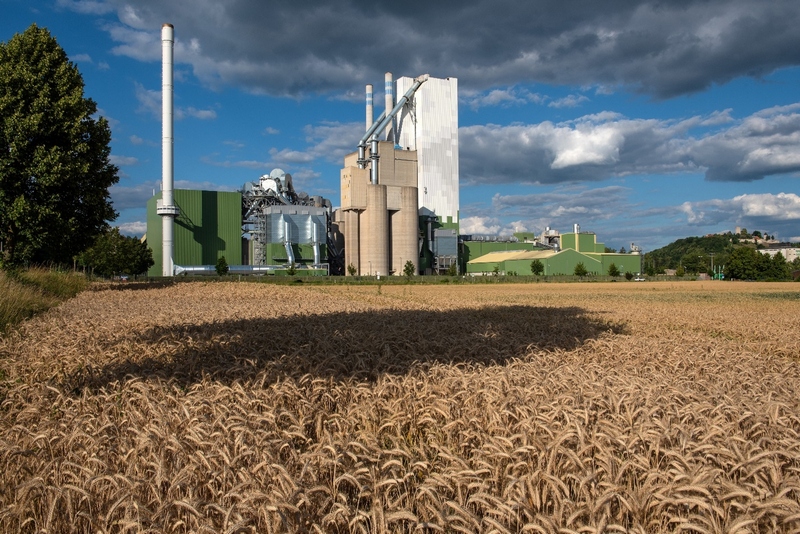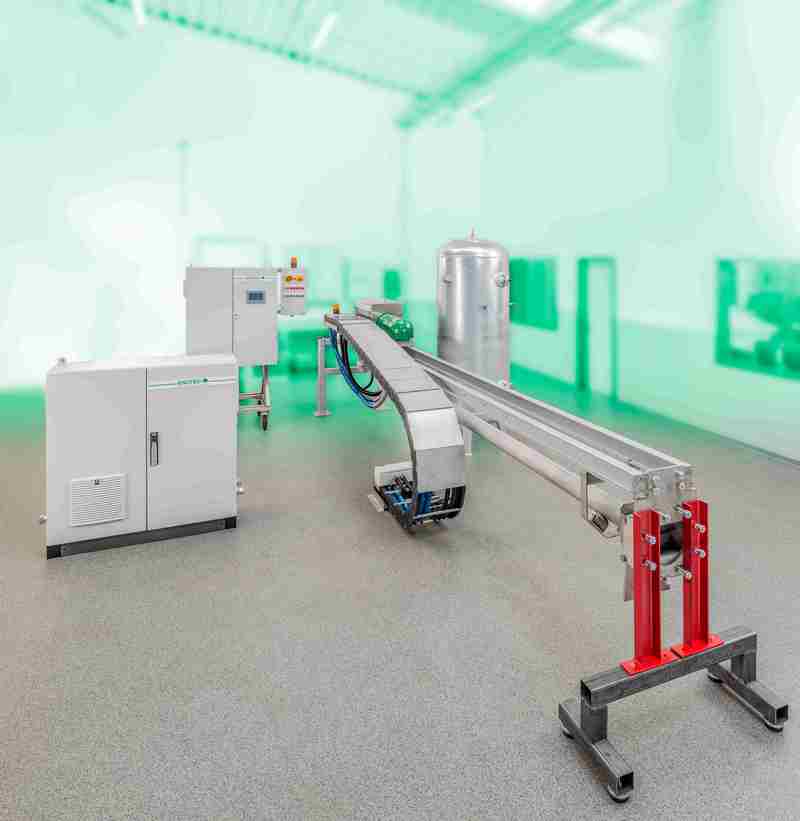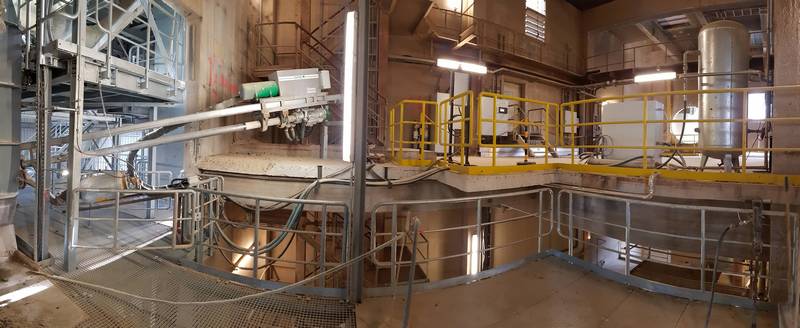
From 2016 to 2018, HeidelbergCement AG modernised its plant in Burglengenfeld with the largest single planned investment in the company’s history to date, amounting to more than EUR 100 million. The aim of this modernisation, which included the purchase of a heat exchanger kiln, was to significantly reduce emissions, continuously increase the proportion of alternative fuels, and ensure consistently excellent product quality. A prerequisite for the realisation of these goals is, among other things, data from the continuous and precise determination of flue gas emissions from the new cement rotary kiln.
Since the inlet chamber between the rotary kiln and the cyclone preheater is one of the most demanding measurement locations in any cement plant, HeidelbergCement decided to use the particularly reliable rotary kiln inlet probe CEMTEC from ENOTEC GmbH. This measuring system for gas analysis was specially developed for the extreme operating conditions in cement plants and, thanks to a patented rotating device and automatic cleaning, enables permanent measurement of the gases directly in the rotary kiln – and thus permanent, accurate determination of the necessary parameters.
The conversion project at HeidelbergCement in Burglengenfeld was carried out during the operation of the existing kiln lines and included a new 5-stage heat exchanger tower with calciner, a shortened rotary kiln, two new grinding plants for limestone with significantly reduced specific power consumption, and a new fabric filter with a separation efficiency of almost 100 percent. The results of this modernisation were the reduction of emissions including the safe compliance with all limit values, the significant increase in energy efficiency, the reduction of CO2 emissions due to the improved efficiency as well as a consistent product quality.
Especially the intended increase in the secondary fuel feed and the additional calciner made the permanently available measurement data of a kiln inlet probe such as the model from ENOTEC indispensable, as the flour and fuel feed, the fuel mix and the air supply are influenced on the basis of its measurement data. The O2, NOx and CO content are recorded and controlled in detail, which, among other things, allows the clinker quality to be kept permanently high. “If you have a clear picture of what is happening at the kiln inlet chamber, you can establish a very good correlation with other process parameters and quickly draw conclusions and make improvements,” says Valentin Hamar, head of the kiln and shift operation at HeidelbergCement, confirming the necessity of gas measurement.

Only probe with all motion functions for permanent operation
The CEMTEC probe used in Burglengenfeld to determine the required parameters essentially consists of the water-cooled sampling probe itself, a compressed air tank, a recooler for the cooling water, the control cabinet for the cooling, the on-site control cabinet and a control cabinet with built-in PLC control. A special feature of the ENOTEC probe is that it is the only model on the market that carries out all the movements required for continuous mass operation fully automatically – from retracting and extending, rotating by ± 45° and tapping to pulse cleaning. All movements are implemented via compressed air, so that a single supply method ensures the safe operation of the probe. In the event of a failure of compressed air or power supply, a 1,000 l compressed air tank forms a sufficient reserve to ensure the safe extension of the CEMTEC. In addition, in the event of a power failure, a battery-operated UPS system (uninterruptible power supply) in the control cabinet ensures that the probe moves into a safe position with the help of its control system. Furthermore, all parameters important for the probe, such as temperatures and pressures, are monitored in order to move the probe out of the process in an emergency and to prevent overheating.
The CEMTEC probe draws the sample gas out of the rotary kiln via the internal sintered metal filter tube. Dust build-up on the internal filter tube and in the sample gas opening is removed by regular tapping – this means that the internal filter tube is regularly axially retracted and extended by means of two pneumatic cylinders so that raw meal caking at the tip of the probe is prevented. This is crucial for reliable analysis, as otherwise hot caking at the sample gas inlet can lower the measured O2 and CO due to oxidation of the flue gas and thus falsify the measured values. All cyclic functions of the CEMTEC – in addition to tapping, these include rotating, backwashing and running in and out – can be variably set via the Human Machine Interface (HMI) and adapted to the respective requirements of the furnace system. The sample gas is conveyed via the heated sampling line into the gas analysis system cabinet and fed to the analyser dried and cleaned via an upstream sample gas conditioning unit. A cold-extractive analysis measurement system adapted to the CEMTEC probe with optimised sample gas conditioning has proven itself here for more than a year.

Reliable measurement data from the day of commissioning
The CEMTEC was installed by ENOTEC in Burglengenfeld in March 2018. The installation went off without a hitch and was completed within a few days, so that the probe reliably delivered measuring gas from the first moment of ignition. In order to keep the risk of falling caking in the kiln inlet chamber – one of the biggest risks in kiln inlet measurement – as low as possible, the probe was also protected by a refractory lining after a short consultation between ENOTEC, the on-site installation company and HeidelbergCement, which proved its worth in subsequent operation. The instruction of the operating personnel of the probe already took place a few days after the first ignition of the rotary kiln. Due to the full function test of the probe at ENOTEC in the plant and its ease of operation, the HeidelbergCement employees were able to take over the operation immediately afterwards. In addition, the probe provided reliable measured values from the first day and thus supported the commissioning and optimisation of the kiln: “Due to the conversion, many values were new for us, but the CEMTEC values at the kiln inlet chamber are an enormously important indication of how the kiln is running. They enabled us to understand the converted kiln quickly and well,” Hamar explains.
After about one year of operation, it could be established beyond doubt that the probe and cold-extractive measurement provided reliable and representative readings without any problems and without much need for maintenance. After 12 months, a regular annual maintenance of the system was carried out, during which only the filter was changed and wearing parts were replaced. Overall, in over two years of operation, the probe has now reliably provided sample gas 90 per cent of the time, allowing the kiln to be continuously monitored and controlled. Even in one case where the analysis results did not seem plausible, the shift personnel, with the support of ENOTEC, were able to quickly verify that the readings from the kiln inlet probe were correct and identify the problem on the kiln itself shortly afterwards. “ENOTEC provides one of the most reliable systems in the plant with their CEMTEC probe. The maintenance requirement is very low and simple,” confirms Norbert Beer, master electrician at HeidelbergCement. “ENOTEC, through their direct communication and fast support, delivers exactly the features that are expected from a medium-sized company and often missed in larger companies.”
With the help of CEMTEC, HeidelbergCement was able to achieve all modernisation goals within a very short operating time. The stricter limits for nitrogen oxides and ammonia emissions, which have been in force since 2019, can be safely complied with, and the product quality could be maintained at a very high level despite the extensive construction project. In addition, the proportion of secondary fuels has been continuously increased and will reach the targeted 80 percent in the near future.













